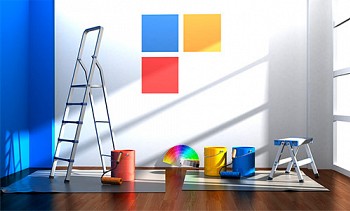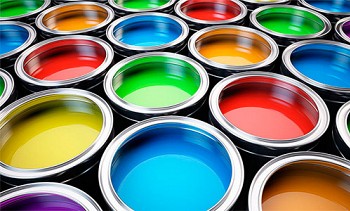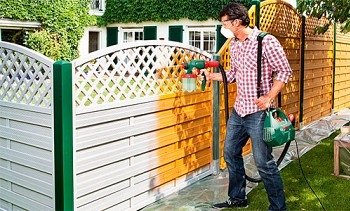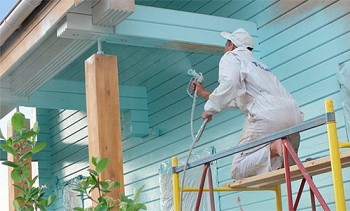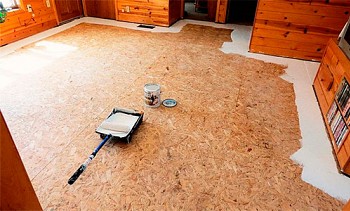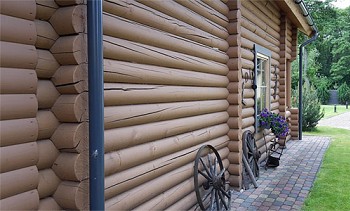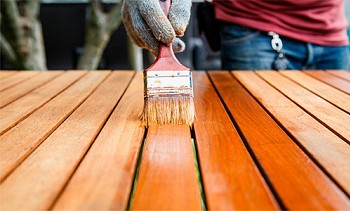The use of paints in construction, repair and design tasks is extremely wide. Paint manufacturers have created hundreds of types of paints, varnishes and other coating materials that can be divided into several groups. Classification can be made according to various characteristics - composition, type of base (film-forming substance), purpose, type of finish surface.
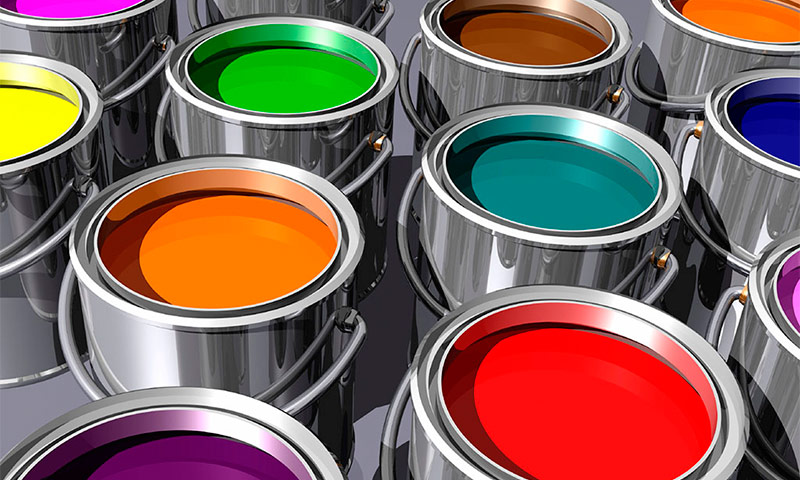
Types of paints by type of film-forming base
The whole variety of paints is based on several types of substrates - fluids of complex composition, which, after drying, form a strong film in which all other components are evenly distributed - pigments, UV protectors, antiseptics, corrosion inhibitors, etc. The film-forming base determines most of the operational properties of a particular paints, so the classification is most convenient to produce on this basis.
In the family of construction and special paints, four groups of paints are most common:
- emulsion;
- alkyd;
- glue;
- silicate.
In turn, they are distributed by type of solvent, for example, oil, nitrocellulose, water-soluble, etc. But the first four classification groups are quite enough to determine the scope of use of the paint, its main properties and capabilities from the marking.
Emulsion and dispersed paints, water soluble
These types of paints are one of the most environmentally friendly. The fact is that the basis for them is pure water, which, evaporating, does not harm anyone either during work or in the drying process. A feature of such paints is their internal structure - acrylic resins and their derivatives or polyvinyl chloride molecules are not soluble in water, they are suspended in the form of emulsions or dispersions (tiny balls).
After application to the surface, these balls are smeared over it, merge and form a monolithic film, mechanically strong and resistant to external influences of a different kind. After drying, the film components are indifferent to water and do not dissolve in it. True, some paints can be washed off using ordinary household products and warm water, but most of the water-based paints create surface coatings that can be washed easily, some even with light abrasives.
Water-soluble emulsion, dispersion and latex paints are intended for almost all types of materials: brick, concrete, wood, drywall, putty and plaster, metal, plywood and fiberboard, chipboard, OSB.
The difference between an emulsion and a dispersion is rather illusory - and one and the other state determines the mixing of two or more liquids that do not interact at the chemical level. That's why dispersed and emulsion paints should be thoroughly mixed before use.
On previously painted with glossy paints and varnishes, as well as difficult in terms of surface finish of glass, tile, ceramics, they should be applied with some caution - only if these materials are indicated in the instructions for the specific type of paint. In most cases, emulsion paints are used to stain enough porous materials. These paints can be used as a base for painting with alkyd paints and varnishes.
Depending on the substances suspended in water, emulsion paints are divided into:
- acrylic;
- polyvinyl acetate;
- latex;
- silicone.
All paints of this group are practically odorless, dry quickly and are fire safe.
Emulsion paints are used, both for internal and external works.But before buying, pay attention to their purpose - by applying interior paint for the facade, you can start re-finishing several months later. The main types of paints for interior use are acrylic, latex, polyvinyl acetate.
Acrylic paints based on acrylic copolymers are less dense and allow the material to breathe. Although they are also applied to dry material, the conditions for their use are simplified. Even if the putty or plaster is not yet completely dry, the paint will allow this to be done in the near future.

Latex paint In addition to acryl copolymers, rubber compounds are also included, as a result of which they form a dense, durable film that can be washed several thousand times using a cloth and soft brushes. Such compositions are used for wall decoration in wet rooms, kitchens, facade works. Look great on wallpaper, wood, metal, some brands of latex paints can be painted glass, tile, plastic.

PVA based paints (polyvinyl acetate) apply exclusively to interior work. The film formed by them, although very decorative, has a low density and is afraid of water and high humidity. Perfectly letting vapors pass and providing free gas exchange, it nevertheless allows moisture to pass through. It can be used only in rooms with a dry and normal microclimate.

Silicone emulsions and dispersions created based on silicone resins. They perfectly resist water, but, at the same time, are vapor permeable. Exceptional elasticity allows the paint layer to withstand significant and rapid temperature changes and mechanical stresses. They have excellent adhesion to most mineral materials and metals, as well as to old coatings from any kind of paint. Their only drawback is the high price.

In their pure form, the basis of emulsion and dispersion paints are rare. Most often in one paint you can find silicone, and acrylic, and latex, and several more polymers. From which component the name comes most and the basic properties of the paint are determined.
Alkyd paints
The most common paints for exterior work and the protection of surfaces in the open. They are widely used in interior decoration, in particular, for painting floors, steps and other surfaces that are under significant mechanical stress.
The main binder is alkyd resin in various varieties. Solvents - drying oil, white spirit, solvent, other organics. After drying, they form very durable waterproof and chemically inert surfaces of varying degrees of gloss. A feature of such paints is that during many years of operation under direct sunlight, they slightly change color and can be covered with a network of microcracks. Based on alkyd resins, oil paints or enamels can be made.
Oil paints based on alkyd resins are made using natural or synthetic drying oil. A distinctive feature is the long (up to several days) drying time. At the same time, moderately toxic substances evaporate from the surface, as a result of which oil paints are used for work outside or in well-ventilated rooms. After drying, they form very durable coatings on all types of mineral materials, wood and metal. Not afraid of ultraviolet and water, very low vapor permeability.

Enamels - Almost the same composition, but with the addition of varnish. The result is a glossy or semi-glossy high-density surface that does not allow moisture to pass, does not enter into chemical reactions and does not change color for many years.

Silicate paint
Silicate paints are made on the basis of liquid glass and have unique properties.They have moderate vapor permeability, are resistant to temperature changes, but the surface layer is quite loose and does not protect against moisture penetration into the base material array. It is usually used on plaster, as it easily tolerates a highly alkaline environment. It is not recommended to paint metals and ceramics with silicate paints, with the exception of special heat-resistant compounds.

Adhesive paints
By their properties and scope they are similar to acrylic emulsions, but less resistant to moisture and suitable only for dry rooms. Usually sold as dry mixes, which are diluted with water before use. In rooms where even a short-term increase in humidity is possible, the walls must be treated with antiseptics and anti-mold preparations before painting. According to the varieties of glue, they can be divided into casein and dextrin.
Casein paints. They are distinguished by a sufficiently high strength of the coating layer and are suitable even for facade work.

Dextrin paints. Designed for interiors, they do not tolerate high humidity, but under normal operating conditions they are quite durable and convenient.
Recently, acrylic and latex compounds have almost completely replaced both casein and dextrin from everyday life.
Special paints
When choosing types of paints for outdoor works and interior decoration, one should not lose sight of special formulations, among which are structural, capable of creating an unusual surface texture and complex shade, and decorative paints that imitate various types of natural and artificial materials.
Structural Paints
After coating with such paints a primed smooth surface, a relief film of high strength is obtained. It can be rough, look like a tree stricken by beetles, imitate water ripples or be covered with a more complex volumetric pattern. After drying, such paints can be coated with acrylic or latex paints or translucent azure. But usually they are tinted in full and themselves play the role of color decoration.

Decorative paints
Decorative paints are designed to create imitation surfaces under: old wood, leather, silk, matting, natural stone. Often they create a metallic or pearlescent shine, rainbow overflow.

Special paints
Various types of special paints also allow you to create some innovative effects, for example, fluorescent ones glow in the incident and reflected rays of extraneous sources, and phosphorescent ones themselves are a light source, giving off the energy accumulated during the day in the form of a dim glow for several tens of minutes.

Paints with various aromas gradually become fashionable, but they can be considered exotic - the smell persists for only a few days after painting. Magnetic paints are also not very common, after drying, they behave like metal surfaces, though only with respect to decorative magnets.
Marking and decoding of paints
A very convenient and practical system of indices and symbols has been developed, which allows you to determine the type of paint and its basic properties at a glance. The data of the most common formulations are shown in the table.
| Designation | Film-forming base |
|---|---|
| HELL | Polyamide |
| AK | Acrylic |
| AC | Acrylic copolymers |
| AC | Cellulose acetate |
| VA | Polyvinyl acetate |
| VN | Vinyl acetate |
| Gf | Gliftal |
| MA | Drying oil and natural oils |
| MS | Styrene and Alkides |
| SC | Nitrocellulose |
| PE | Polyester |
| PF | Pentaphthalic |
| Ur | Polyurethane |
| HL | Shellac |
| Ef | Epoxy resin |
| ET | Polyethylene |
| FP | Ftoroplast |
| EC | Ethyl cellulose |
| F | Phenolalkides |
The most common compounds that have to be dealt with both in professional construction and in household repairs are marked in bold.
No less important are the numbers immediately after the letter index.The first digit indicates the scope of application of the paint, the numbers following are the serial number.
| 1 | Resistance to weathering. |
| 2 | For internal work. |
| 3 | For metal. |
| 4 | Not damaged by hot water. |
| 5 | Special. |
| 6 | It is steady against fuels and lubricants. |
| 7 | For use in aggressive environments. |
| 8 | Heat resistant. |
| 9 | Electrical insulating. |
| 0 | Primers. |
Oil paints (MA) also have an additional digital index indicating the type of solvent.
- 1 - natural drying oil,
- 2 - oxol;
- 3 - glyphthal;
- 4- pentaphthal;
- 5 synthetics and combined composition.
The purpose of paints is to decorate the surface and protect it from external influences. This dual task, most paints perform "excellent" in only one case - if you choose the right composition. He must:
- have a high level of adhesion (adhesion) to the material that is painted;
- after drying, maximally correspond to the operating conditions of the surface;
- Do not collapse under the influence of atmospheric factors and moisture;
- hold color firmly;
- do not emit toxic substances.
When choosing paint for interior or facade decoration, as well as painting other structures, first of all, it is necessary to focus on the scope of the paint and its compliance with operating conditions. When choosing a composition for previously painted surfaces, you must make sure that it will not enter into undesirable reactions with the previous coating layer. In case of a conflict of components, it is necessary to find another paint that is more suitable for work.
Then, with equal parameters, to the manufacturer. The modern market is full of colors, but there are not many high-quality ones among them. It is best to buy products from well-known brands, even if its price is slightly above average.


